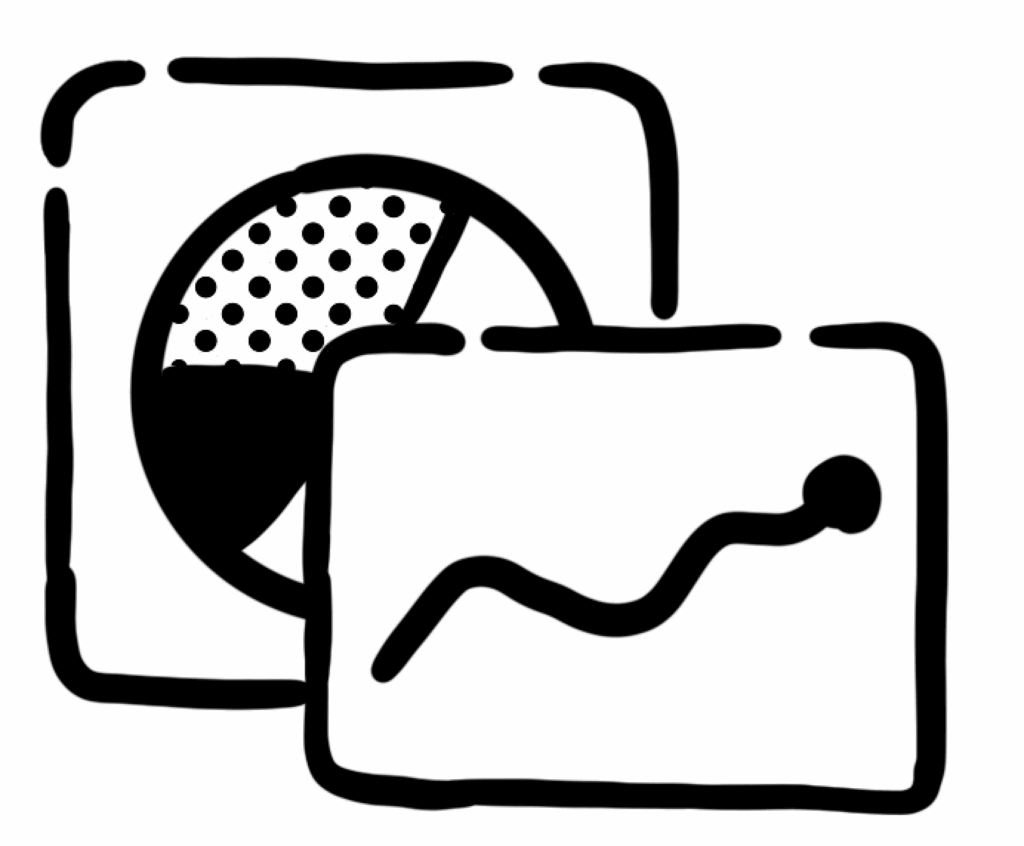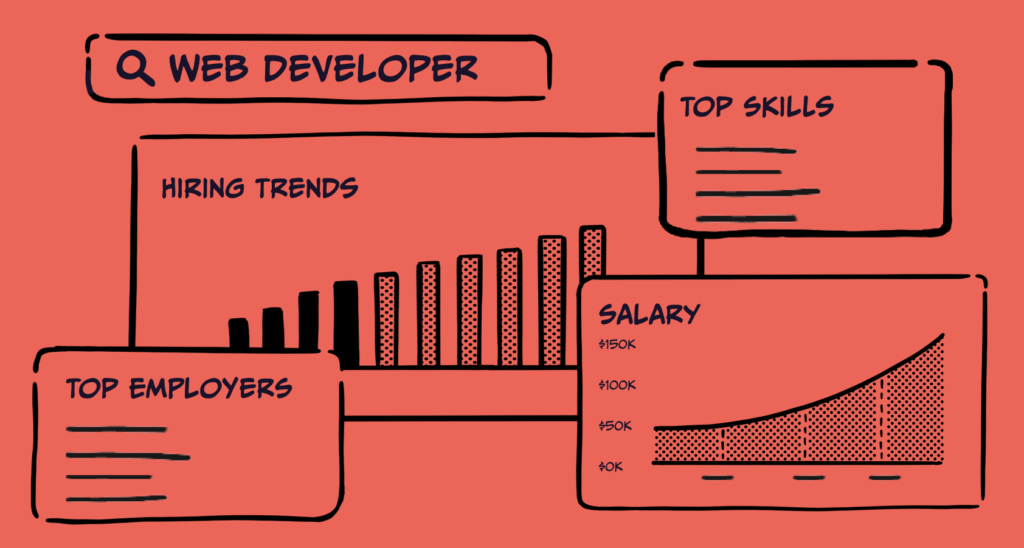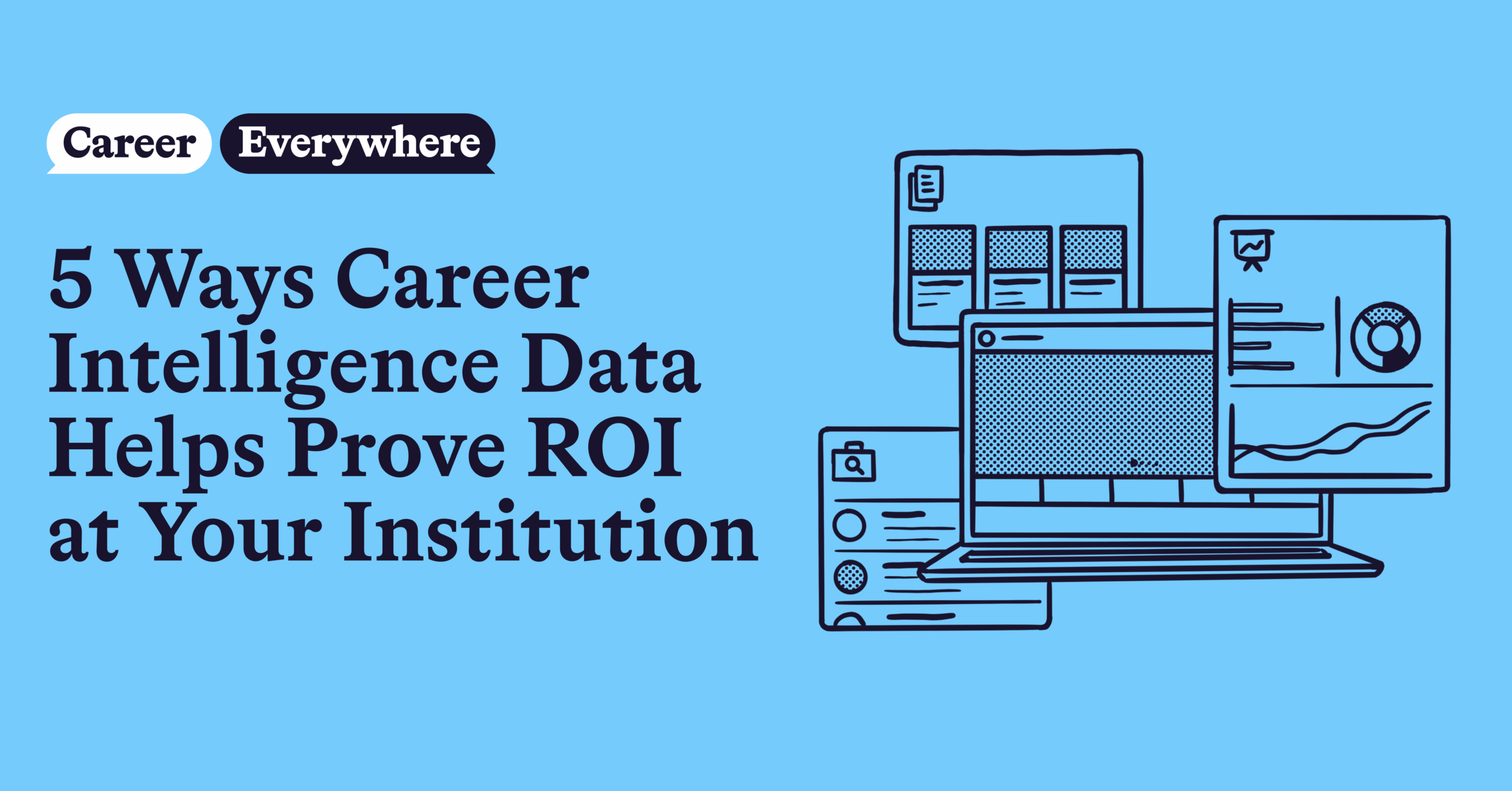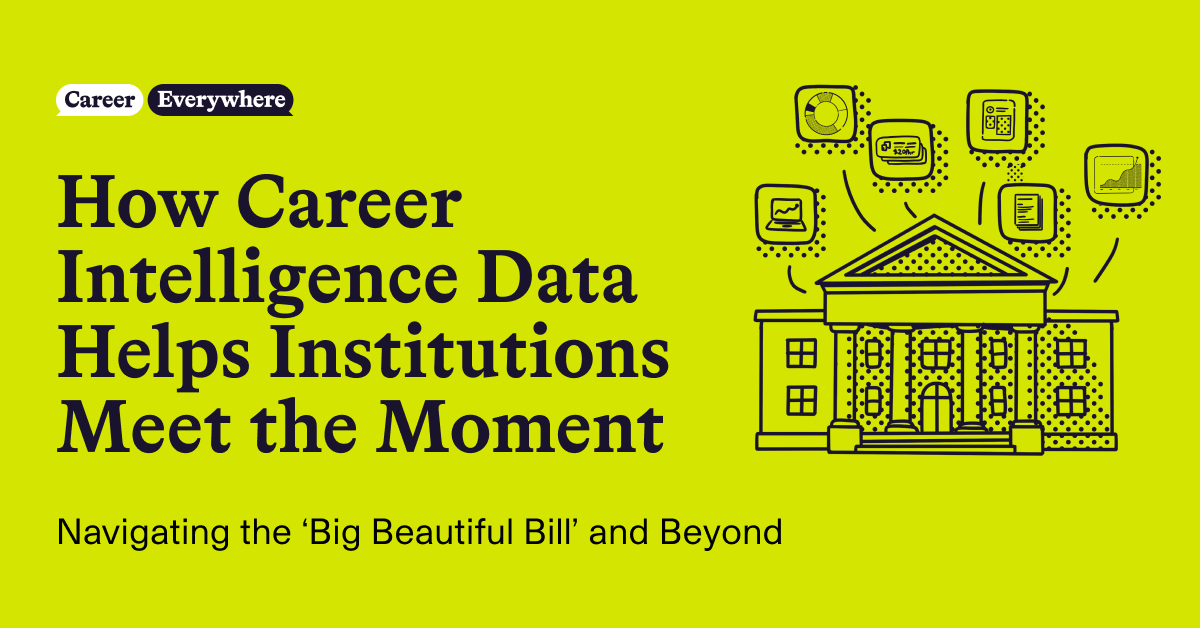
Colleges and universities face an unprecedented mix of pressures these days: Declining enrollment, rising student (and family) expectations, increasing competition, budget challenges, policy changes, and heightened demands for accountability around career outcomes.
With the cost of higher education remaining stubbornly high, students and families no longer see a degree as just a ticket to knowledge or a rite of passage into adulthood, they see it as an investment. And they want proof that it will pay off.
Yet, many enrollment teams face a major knowledge gap when addressing these expectations. They lack consistent access to student success stories (and the outcomes data to put them in perspective). Or they don’t know the full spectrum of what career services offers and how students are supported with career readiness.
Too often, admissions relies on one-off anecdotes or old rankings, which makes it challenging when a prospective student or parent asks, “Okay, but what about this other major?”
That’s where career services and enrollment management can become powerful allies.
“The career center should be front and center in your recruiting effort,” said Michael Griffin, a higher ed strategist and former VP for Enrollment Management, during a recent episode of the Career Everywhere Podcast. “Families are focused on jobs and careers, and they want to know, ‘If I go to your institution, what does that pathway look like?’”
Historically, these two offices have often operated in silos: Enrollment teams focused on getting students in the door, and career services focused on helping them get out the door into the workforce. But forward-thinking institutions are realizing that when these two units collaborate intentionally, they can strengthen the entire student journey—from recruitment to retention to post-graduation success.
Across the country, schools like Bowling Green State University (BGSU), Binghamton University, and Wentworth Institute of Technology are showing what’s possible when these two teams collaborate deeply. The result? Record-breaking enrollment, improved retention, students who are thinking about their careers from day one, and graduates who feel prepared to enter the workforce.
Here are 10 ways career services and enrollment management teams in higher education can collaborate to improve enrollment, retention, outcomes, and more.
10 ways career services and enrollment management can partner for impact
Whether your teams already collaborate occasionally or you’re just getting started, here are 10 tactical, real-world strategies to build a more connected, outcomes-driven student experience—starting before students even set foot on campus.
1. Build a community page for prospective students on your virtual career center or career center website
One of a career center’s most powerful—and visible—assets is its virtual career center (like the ones powered by uConnect) or a traditional website.
When a prospective student or their parents Google “career services at BLANK university,” are you proud of what shows up in the results? Do you have resources curated specifically for prospective students?
If not, now is a great time to build a prospective students community page on your website or virtual career center. This gives prospective students and their families a glimpse into the kind of 24/7 career support they’ll get while at your institution—which can make or break their decision to enroll.
Plus, it’s a useful and easily accessible resource for campus tour guides and admissions counselors, too.
Here are a few examples of prospective student community pages:
Note: All of the above examples are built on uConnect’s Virtual Career Center platform.
2. Make career services a visible part of campus tours
At Binghamton University, the career center is a major stop on every campus tour. Student tour guides are trained to speak about their own career development experiences, giving prospective students and their families real-life examples to connect with.
“The most important thing the guides do is talk about how they’ve used career services themselves,” said Melissa Lawson, Binghamton’s Director of Admissions Communications. “Families remember those stories far more than a list of services or facts and figures.”
3. Co-program events for admitted and prospective students
Binghamton’s career services team presents at admitted student days and open houses, not just at a table, but as part of dedicated sessions tied to Binghamton’s career cluster model. Admitted students interested in a specific career cluster—like business and entrepreneurship, for example—can attend a session led by a career consultant who specializes in that cluster.
This helps admitted students (and their parents) visualize what’s possible in terms of career pathways and outcomes, leading to a higher chance of enrolling at Binghamton. And if they do enroll, they’re much more likely to engage early with the career center.
“We have had an increase in students, before they even commit to Binghamton, wanting to talk to the career center and walk through their different options. They’re asking us questions like, ‘Why would I go here versus there?’” said Lexie Avery, the Senior Associate Director of Student Engagement and Career Readiness at Binghamton.
“I can tell them that if you major in X, these are the types of internships, these are the roles that alumni go on and graduate with, and these are the companies they’re currently working at.”
4. Feature career outcomes and information in admissions marketing and academic program pages
Career outcomes data is one of the most compelling parts of a university’s value proposition because it shows proof, not promises. It helps show prospective students and their families what is possible with a degree from your institution.
It can also help inspire students to think outside the box when it comes to career pathways, before they even step foot on campus. But first, they need access to that data. And ideally, it would be interactive and easy to navigate.
“Admissions leaders are getting grilled on outcomes,” said Rebekah Paré, a former longtime career services leader and Chief Strategy Officer at Paré Consulting. “If career services can provide not just the numbers, but the stories behind them, it’s a huge value-add to the recruitment effort.”
Career services can support their counterparts in enrollment management by proactively sharing outcomes data, along with relevant context and storytelling. Then, enrollment can use student success stories, First Destination Survey data, and alumni outcomes in recruitment brochures, emails, and campus visit talking points. You can add this information to your institution’s homepage or admissions website, too.
For example, on the academics section of the University of Washington’s admissions website, there’s a “Student Outcomes” link that takes visitors to a dedicated outcomes page, where prospective students can explore the interactive data themselves.
Outcomes data is also embedded on all academic program pages, including this one for Aeronautics and Astronautics.
At BGSU, they include information and a video about their Life Design approach to career exploration right on the university homepage.
Note: Many career centers (including University of Washington) use uConnect’s Outcomes Data Visualization module to showcase FDS data on their virtual career centers, admissions pages, and academic program pages.
5. Train admissions counselors to talk about career services
Admissions counselors are expected to know a little bit about everything, including career outcomes. And while it’s not realistic to train counselors on everything career-related, career services teams can empower them with key talking points, stats, and student success stories to help them address common questions.
This includes creating a central place where stakeholders can easily find all of that information, and making sure the admissions team knows about it. For many institutions, like Wentworth Institute of Technology (WIT) and Binghamton, their virtual career centers serve that purpose.
- WIT’s virtual career center (powered by uConnect)
- Binghamton’s virtual career center (powered by uConnect)
Christine Cruzvergara, Chief Education Strategy Officer at Handshake, suggests that career services teams should prioritize two specific data points when sharing with admissions (or senior leadership):
- Outcomes rate
- Internship rate
This is what most students and parents are interested in, it makes it easier for busy admissions teams to remember (versus a whole one-pager of stats), and it keeps messaging consistent.
“Boil it down to what is the most critical so admissions can get your message correct every single time. Make sure your narrative is essentially a one- or two-sentence thing that anybody who’s not in your function can actually remember. Because if your message is too diffused, you’re not helping yourself. Keep it short and simple,” Cruzvergara said.
“If you have a better data point that is more unique for your school that you want to highlight, by all means, feel free to weave it in. But sometimes you don’t have to reinvent the wheel. Just make sure those data points are as strong as possible,” she added.
In addition to proactively sharing data, the Binghamton career services and admissions teams also collaborate on annual trainings. Career staff lead these trainings, ensuring admissions teams are equipped to speak about career resources, internships, mentoring, and alumni connections confidently and accurately.
Pro tip: If you have a uConnect-powered virtual career center, walk your admissions colleagues through the platform and highlight all the 24/7 resources you offer, the data students can explore, and the automated (but personalized) communications you send.
6. Collaborate on incoming student communications
At Binghamton, incoming students receive career-focused messaging before they even arrive on campus. Communications highlight programs like a two-credit online summer career exploration course and the career center’s Kickstart Your Career program for first-year students.
“We want students to start thinking about career from the jump,” said Lawson. “That pre-orientation window is a huge opportunity.”
7. Include career services representatives in recruitment events
When recruiting in-state, out-of-state, and international students, Binghamton’s admissions and career services teams occasionally travel and present together to share what makes the university stand out—including deep career support.
“It’s one thing for an admissions counselor to say we prioritize outcomes,” Avery said. “It’s another to have a career services expert right there explaining how we help students land internships and jobs.”
8. Leverage each other’s data to inform messaging and strategy
As Paré noted, career services teams don’t always have the same marketing reach as admissions—but they do have compelling student stories and powerful outcomes data.
And admissions teams have great information about the incoming class and what might be important to them when it comes to career exploration.

For example, Binghamton’s admissions team sends a survey to all incoming students before classes start that includes a question about what influenced their decision to choose Binghamton. This year, Lawson said over 70% said they were influenced by the availability of internship opportunities at Binghamton and the career placement of Binghamton alumni. And over 90% said there was a high likelihood that they’d participate in an internship while at Binghamton.
That is extremely valuable information for the career center to have as they plan outreach, programming, and content for incoming students.
By working together, enrollment and career teams can create a seamless experience for new students—from choosing an institution to enrolling in an online summer career exploration course to visiting the career center once classes start.
That’s great for enrollment and retention.
9. Integrate career exploration into the first-year experience
At BGSU, which leans heavily into a campus-wide life design approach, first-year students can take a one-credit life design course that equips them with a “framework and tools to design academic, career, and life experiences that align with who they are, what they value, and what they want to do in life.”
This course, and the general emphasis on life design and helping students build early momentum, has led BGSU to see record enrollment and retention rates in recent years. It makes career exploration part of the campus culture, not a last-minute scramble.
“We’ve built an ecosystem where students thinking about careers is built in, not bolt on,” said Steve Russell, AVP of Corporate Partnerships and Executive Director of the Kuhlin Hub for Career Design and Connections.
Helping students connect their major to a meaningful career path early not only improves outcomes—it helps them stay enrolled. Students who see the relevance of their coursework and experiences are more likely to persist through challenges.
“It’s about helping students invest more into their experience, so they get more out of it,” said Russell. “That leads to stronger retention and better outcomes.”
And with those better outcomes comes a stronger story BGSU’s admissions team can tell prospective students and families, which leads to more enrollment and kickstarts what we call the Career Services Flywheel.
10. Position resources like job market data as a differentiator for prospective students
As prospective students and families pepper admissions teams with questions about outcomes, internships, and specific examples of student success, what they’re really looking for is information.
Data-backed information.
They want assurance that your institution is equipped to prepare students for a successful life and career after graduation. That you value the process and are intentional about career readiness.
Knowing this, Wentworth Institute of Technology invested in Career Intelligence Data (a strategic combo of forward-looking labor market data and backward-looking outcomes data). They share their outcomes data (presented via uConnect’s Outcomes Data Visualization module) with admissions so the data is accessible on the admissions website and on their virtual career center.

They also highlight job market data (presented via uConnect’s Labor Market Insights module) on their virtual career center, particularly on career community pages like this one for Business Management/Administration.
The job market data—which tracks hiring trends, in-demand skills, salary benchmarks, and where the job market is headed—is a great tool for helping prospective students see a tangible path from classroom to career. It helps them explore different career pathways and make educated decisions about what to major in, what skills to learn (and how to articulate them), and what is possible financially.
The job market data has empowered the WIT team to guide students beyond the Boston area, filling gaps in institutional knowledge and providing data-backed advising for students exploring national job markets.
Having this resource, and making sure admissions knows about it, too, has been a major differentiating factor for WIT. It signals to prospective students and parents that WIT is serious about career readiness.
And it’s clearly worked. In Fall 2024, WIT welcomed their largest incoming class in the institution’s 120-year history (an 11 percent increase over 2023).
“Our students have great career outcomes, and we’re telling their stories—and our story—better,” Amy Sison, Associate Vice President of Enrollment and Dean of Admissions at WIT, said in this article.
Conclusion: It’s time to align around outcomes
In a time of shifting demographics, growing skepticism about higher ed, and fierce competition for students, career services and enrollment management can no longer operate in silos. They need each other.
As Griffin put it: “Career services isn’t just about resumes anymore. It’s a key part of your institution’s value proposition.”
And when enrollment leaders and career teams collaborate, everyone benefits—from prospective students and their families to current students navigating their path to meaningful, purpose-driven careers.
Want to hear more real-world examples? Check out the Career Everywhere Podcast to hear firsthand how leaders across higher ed are building stronger partnerships—and transforming the student experience.


